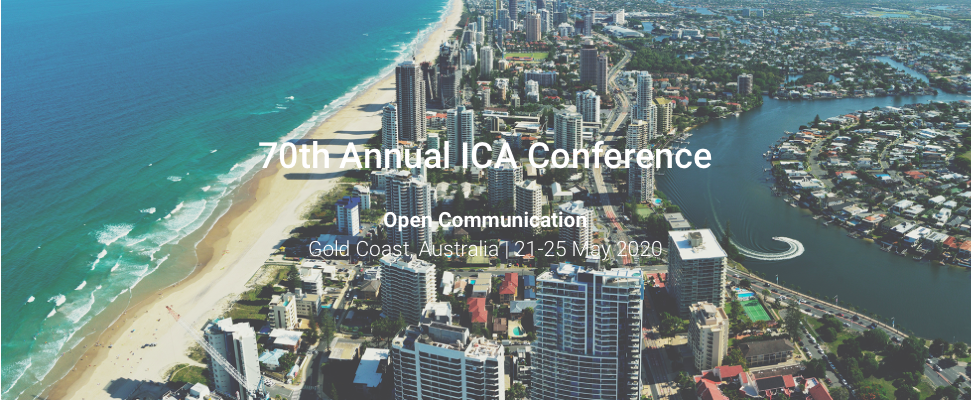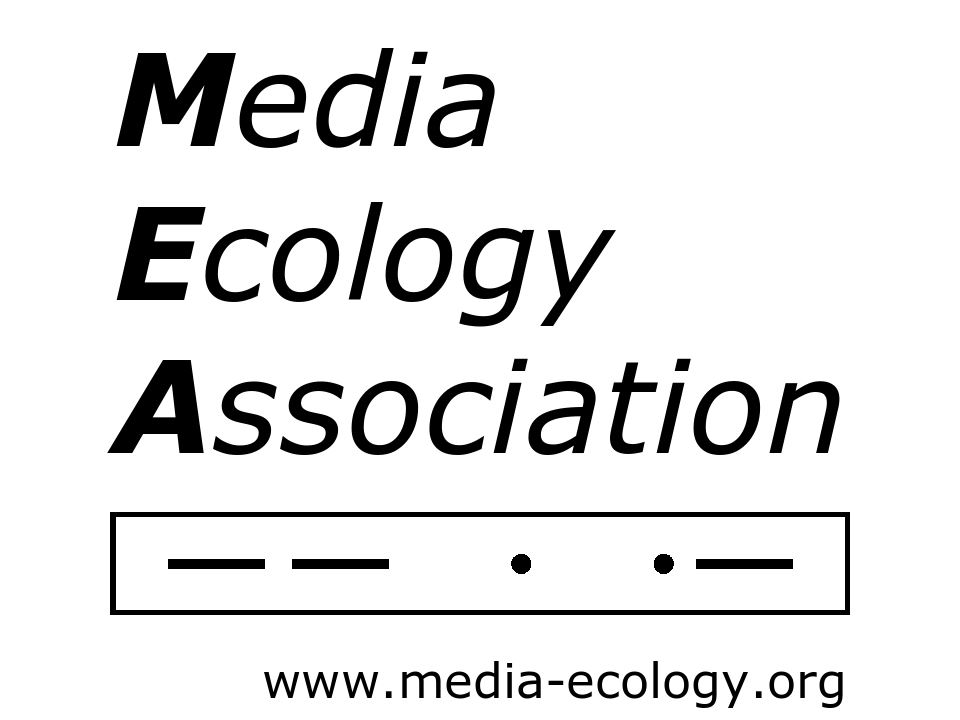MEA @ ICA 2020
UPDATE: Due to the COVID-19 pandemic, this year’s ICA conference has been converted to a virtual format. Click here for more details.

The Media Ecology Association is sponsoring the below panel at this year’s International Communication Association conference, May 20–26, 2020.
More info from the ICA:
The conference will be asynchronous, as we have members/attendees in 87 countries and there is no time zone that accommodates everyone for a live session. The platform will be open 24 hours a day from 20 May to 26 May and you can log in, view content, and make comments at any time during that time. Do note that because our platform provider is in Canada, customer service/tech support will be available only during about half of that time (daytime at their office). At any point during that week, you may log in and engage with as much or as little content as you desire.
How do I log in? For everyone who has registered directly with ICA, we will upload that list and contact information to the platform and they will each receive an invitation email.
Can I visit the conference without paying? Unfortunately, no. We have to use the same registration system as always, and that list will be given to the platform administrators. Only those who are paid registrants will have password-protected access to the platform. You may not visit the exhibit hall, upload a video, view videos, upload or view posters, or anything else within the app without a registration log-in.
Open Media Ecology, and Openness to Media Ecology
Chair: Laura Trujillo Liñán, Universidad Panamericana, Campus México
1. Scott Haden Church, Brigham Young University and Gavin Feller, Umeå University - “Simpsonmemes and the Swarm Archive: Or, Toward a Meme Ecology”
This essay proposes an updated interpretation of meme ecology to include internet memes and digital remix. Independently, an internet meme cannot be understood on its own because it constitutes a network of variegated remixed material. The meme ecology posits that cultural transmission is separate from human intervention, though remix subverts this idea as it is dependent on algorithms to find an audience. In order to understand video memes in digital culture, a framework for understanding the ecology in which they live must be examined in terms of time and space and the symbiotic relationship in which they are created by vernacular voices and proliferated by algorithms. The concept of an open versus closed meme provides yet another dimension to meme ecology as a way to understand the politics and power of meme boundaries (i.e., who can and can’t make certain memes, who will understand them, etc.).
This essay puts forth the concept of a swarm archive, which comes into being through the diachronic movement of the text and the valuable marginalia it picks up along the way. The popularity of The Simpsons coupled with Internet fan culture has produced copious remixed Internet memes from the show. Like Quintilian’s classical text Institutio Oratoria, which has evolved through time and culture into “Quintilianisms,” or essential, non-authorial iterations of the text, The Simpsons has evolved into a Simpsonalia, a swarm archive. This analysis of Simpsonalia is a representative case of our proposed digital meme ecology.
2. Paige Lee, Brigham Young University - “A Social Critique of ‘Radio Gaga’: The Influence of Radio to Television on Culture”
Innovation in technology has immensely impacted our culture, leaving society with a loss of potential for impactful content in entertainment mediums. A pattern of continuous diminishment in existing mediums show that whatever new technology is given to the public is presented and viewed as valuable, disregarding the power and the potential of media environments to influence positive change in culture. With this analysis, we argue that the introduction of television diminished the perceived value of radio because it engaged more than just listening and provided entertainment that consumed our society. We analyze the song “Radio Gaga” to ironically show the potential for cultural development in media through a lyrical evaluation of historical contexts and a critique on the advancement of new technology. The pattern of development in new technology has continued and will continue, creating a culture where existing media will fail to reach its full potential.
Keywords: Radio, Television, Neil Postman, Queen, Technology.
3. Laura Trujillo Liñán, Universidad Panamericana, Campus México - “Open Communication in a Posthumanist Age”
The development of technology and access to information is increasing: we have new technologies that allow us to access more accurate information about our reality and the world in general. Likewise, this information is increasing to the point that it is not possible to arrive at knowledge of everything that is offered to us. In the beginning, the purpose of this information was for the benefit of man: for his development and increasing knowledge in different areas, and wherein he could develop himself in better ways. However, what we have come to realize is the limitations we have. It seems, according to some theories, that we have reached an era of suppression of man because his abilities have reached their limit, and that it is now time for man to yield his place to the era of post-humanism, wherein technology has the power and helps man as something inferior to it.
In addition, MEA members will be presenting media ecological work outside of the MEA’s sponsored panel, including…
Carolin Aronis and Natasha Shrikant, University of Colorado Boulder - “The (Ideological) Journey of Sojourner Truth’s Well-Known Speech: From Oral to Written and Back”
(Division: Ethnicity and Race in Communication)
The 19th century Black American activist, Sojourner Truth, gave a remarkable speech in 1851 in Ohio. Over the past 170 years, numerous activists and scholars transcribed, re-transcribed, edited, published, reprinted and performed this speech across multiple media platforms (e.g. historical books, textbooks, poetry, plays, conferences, YouTube). These numerous reiterations of the speech stemmed from two very different original versions transcribed by journalists attending Truth’s performance. A critical analysis of this speech’s journey—its rhetoric along with its mediated practices—reveals the politics behind transcriptions, the white appropriation of literacy tools, and the remediation of Truth’s voice as it suited for the needs of times, contexts, publishers, and readers. More specifically, the paper shows how written transcriptions perpetuate white, hegemonic, often racist mediation of black voices and bodies, it also illuminates how these interestingly allow the speech’s reclamation by black/African-American women activists on YouTube whose performances revive suppressed historical and present-day identities. Tracing these changes provides insight into the relationships between black and white voices and communicative practices and the politics of media technologies/environments. Conclusions discuss implications for theorizing the role of Remediation and race, particularly in US contexts.
If you’re presenting media ecological work and would like your presentation listed here, contact us!
More details will be added to this page as they become available.
